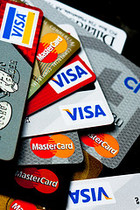Budgeting is like exercising for many people: We know we should do it, and we really want to, but after a long day, it's pretty much the last thing on our minds.
What if it could be easy? If you could tackle it without all the stress? In this article, you'll learn about the four key steps in taking control of your spending and your finances without all the agony.

photo credit: Josh Kenzer via photopin cc
The Way Your Mind Works: Mental Accounts
Take a second and estimate your annual income. Got it? Now quickly estimate your annual expenditures.
It's a lot harder, isn't it? Most people can easily tell you their earnings but can't even come close to estimating their total spending. Now try something else: How much did you spend on gas last month? This might not have been as quick as figuring out your earnings, but it wasn't that difficult, right?
It's easier to estimate a category of expenditures because we have a natural tendency to divide our spending into what behavioral economists call "mental accounts". In other words, we naturally split purchases into categories, such as the mortgage and the groceries, and the result is that it's much easier to estimate what we spent on each one.
When it comes to tracking your spending, take advantage of your natural tendency to categorize. Think about your major expense categories for a few moments. The list probably includes things like housing, household bills, insurance, groceries, eating out, etc. How much do you spend in each one?
The best advice I can give you is to take a look at this Bradford Pine Wealth Group Expense Analysis Worksheet, which I am confident will help you in the process of tracking and understanding your spending. It allows you to put in your monthly expenditures in the appropriate categories and automatically calculates your annual totals, which gives you a detailed picture of where your money is going.
Gathering Data
Now, some of the categories you put together might be difficult to estimate, and the amounts in others might include a bit of wishful thinking. So I also recommend that you take the time to track your actual expenses.
There are as many ways to track spending as there are people. Some prefer to regularly look back through their check registry and credit card statements, others collect receipts, and some may prefer to keep a running list of their expenses on a Smartphone or piece of paper. You can also use online tools like Mint or software like Quicken, which link to your bank accounts and automatically track your expenditures for you. Many of my clients find our Expense Analysis Worksheet to be very helpful. Once you've filled it out once, it's easy to update it regularly and keep track of your spending habits over time.
Whatever your strategy, I encourage you to try this out for a month, then compare the results to your estimates. While you're at it, take a look at your debt and savings habits. What are you spending money on? Are you setting money aside? Do you carry a balance on your credit cards? Your future self will thank you for asking these questions and getting your spending under control.
Making a Plan
Once you have all the data together, it's time to make a plan. Start with the big picture. What are your goals? What do you love to do? These might sound unrelated to budgeting, but, in the end, money is supposed to help you do the things that you want, so it's an important place to start. For example, if you're looking to start a business, you might want to think about saving more while you can to ensure a smoother ride during your start-up phase. If you're carrying credit card debt, consider how it might be holding you back from tackling that home renovation or going on that dream vacation.
It's also important to communicate with your spouse. Are you both fully aware of your financial situation? Is your spouse oblivious to your debts? Having a heart to heart about what's going on and what you dream about is a critical starting point to making a new spending plan.
From here, you can get down to the basics. What categories are out of whack? Are you spending more than you're earning? Should you be contributing more to your 401(k) or IRA? Have you started a 529 plan for your newborn?
While it seems daunting at first, you might be surprised that there are places you can cut that are not all that painful. And by re-organizing your finances so that you can meet your big goals, whatever they may be, you might find yourself much happier overall!
Adjusting for the Long Run
Once you've made some decisions, it might be time to readjust to a new spending pattern. I find that putting bills and savings on automatic pilot is an amazingly useful tool when you make these kinds of changes. Not only does automation free up your mental energy for managing your discretionary spending, but it can help make it easier to achieve your goals and better manage your finances.
Of course, it can be difficult to adjust to a new system, so throughout it all try to remember that the benefits of reaching your end goal, whether it's having more fun, carrying less debt, or ensuring a more secure future, are immeasurable. Taking control of your spending will not only put you at ease in the short term, but it can set you up for more fulfillment and happiness in the long run. And isn't that what life is all about?
Please let me know if you find my Expense Analysis Worksheet to be helpful or if you have feedback about any enhancements you'd like to see on it!
Written by Bradford Pine with Anna Wroblewska.
